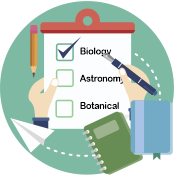
Pinterest offers unique features and benefits that can be highly advantageous for scientific illustrators. Let's explore why Pinterest is a valuable platform for showcasing your work:
Visual Discovery:
Pinterest is all about visual discovery. Users actively search for inspiration, ideas, and beautiful visuals, making it an ideal platform to showcase your scientific illustrations. By creating visually captivating pins, you can capture the attention of users who are actively looking for content related to science, education, or art.
Longevity of Pins:
Unlike other social media platforms where posts quickly fade into obscurity, Pinterest pins have a longer lifespan. Pins can continue to surface in users' search results and recommendations for months or even years after they are initially pinned. This means that your scientific illustrations have the potential to gain exposure and generate engagement over an extended period.

Organizational Boards:
Pinterest's board system allows you to curate and organize your scientific illustrations into themed collections. Create boards that align with specific scientific topics or themes related to your work. By organizing your illustrations in a visually appealing and structured manner, you make it easier for users to navigate and discover your content.
Linking to Your Website:
Pinterest allows you to link your pins directly to your website or blog. This feature is especially beneficial for scientific illustrators who want to drive traffic to their portfolios, online stores, or other platforms where they showcase their work. By linking to your website, you can increase the visibility of your illustrations and potentially attract new clients or collaborators.
Community Engagement:
Pinterest is a platform that encourages engagement and collaboration. Users can repin, like, and comment on your pins, creating an opportunity for meaningful interactions. Engage with the Pinterest community by responding to comments, following relevant boards and users, and actively participating in group boards related to scientific illustration. This can help you build connections, expand your reach, and gain valuable insights from fellow artists and enthusiasts.

Trendspotting and Inspiration:
Pinterest is a treasure trove of inspiration and trends across various industries. As a scientific illustrator, you can leverage this by keeping an eye on trending topics, visual styles, and techniques within the scientific and art communities. Stay inspired by exploring popular pins and trends, and incorporate them into your own unique style to keep your illustrations fresh and relevant.
SEO Opportunities:
Pinterest functions as a search engine, and optimizing your pins with relevant keywords can help your content appear in search results. Research and use targeted keywords related to your scientific illustrations to enhance the discoverability of your pins. This can increase the likelihood of attracting users who are actively searching for content in your niche.
Guide to Create Eye-Catching Pins
Creating eye-catching pins for Pinterest can help you capture the attention of users and drive engagement. Here's a friendly guide to help you through the process:
1. Choose Compelling Illustrations:
Start by selecting your most captivating and visually appealing scientific illustrations. Opt for images that are clear, high-resolution, and have a strong visual impact. Choose illustrations that effectively convey the subject matter and evoke curiosity or intrigue.
2. Design Vertical Pins:
Pinterest favors vertical pins with an aspect ratio of around 2:3 or 1:2.8. Create long, vertical pins that stand out in users' feeds and maximize the available screen space. This format ensures your pins are easily viewable and piques users' interest as they scroll through the platform.

3. Add Informative Text:
Overlay your pins with concise and informative text that adds context to your scientific illustrations. Use clear, legible fonts that are easy to read, even at smaller sizes. Include catchy titles or intriguing captions that highlight the key concepts or benefits of your illustrations.
4. Select Vibrant Colors:
Use vibrant and eye-catching colors in your pins to make them visually appealing and attention-grabbing. Consider using a consistent color palette that aligns with your brand or creates a cohesive look for your scientific illustrations. Experiment with color combinations that enhance the overall impact of your pins.
5. Incorporate Branding:
Establish your brand identity by adding your logo or website URL to your pins. Place them strategically in a corner or at the bottom to avoid overwhelming the main focus of your illustration. Consistent branding across your pins helps users recognize and associate your content with your unique style.

6. Create Engaging Pin Descriptions:
Craft engaging and keyword-rich pin descriptions that accurately describe the content of your scientific illustrations. Use relevant keywords that align with your target audience's search queries to enhance the discoverability of your pins. Make your descriptions informative, concise, and inviting to encourage users to engage with your pins.
7. Utilize Rich Pins:
Take advantage of Pinterest's rich pins feature, which allows you to add additional details to your pins automatically. For scientific illustrations, consider using article pins or product pins to your web site to provide more information. Rich pins can enhance the user experience and provide additional value to your audience.
8. Test Different Pin Designs:
Experiment with different pin designs to see what resonates best with your audience. Try variations in colors, layouts, and text placement to understand what captures users' attention and generates the most engagement. Pinterest analytics can provide valuable insights into the performance of your pins and help you optimize your designs.
9. Create Multiple Pins for Each Illustration:
Don't limit yourself to just one pin per illustration. Create multiple pins with different designs, text variations, or perspectives to cater to different user preferences. This approach allows you to test different pin styles and increase the chances of your content reaching a wider audience.
10. Consistency and Regular Pinning:
Maintain a consistent presence on Pinterest by regularly pinning new content. Establish a schedule that works for you and stick to it. Consistent pinning helps keep your audience engaged and boosts your visibility on the platform.

Remember, creating eye-catching pins on Pinterest is all about combining visually striking illustrations, informative text, and thoughtful design choices. Experiment, analyze the performance of your pins, and adapt your strategies based on user engagement and feedback. By following these tips, you can create captivating pins that effectively showcase your scientific illustrations and attract the attention of a relevant and engaged audience.
Optimizing Your Pinterest Boards
Optimizing your Pinterest boards can help you attract the right audience and showcase your work effectively. Here's a friendly guide to help you through the process:

1. Define Board Categories:
Start by defining clear categories for your Pinterest boards that align with your scientific illustration topics. Think about the different subjects or themes you cover in your work and create boards around those topics. For example, you could have boards dedicated to biology, astronomy, chemistry, or specific scientific techniques.
2. Use Descriptive Board Titles:
Choose descriptive and keyword-rich titles for your Pinterest boards. Use specific terms that accurately represent the content within each board. This helps users understand what they can expect to find when they explore your boards and improves the discoverability of your content in search results.
3. Curate Relevant Content:
Populate your boards with a mix of your own scientific illustrations and other high-quality content related to your field. Pin content from reputable sources, scientific journals, educational websites, or fellow scientific illustrators. Curating relevant content helps establish your expertise, provides value to your audience, and encourages users to follow your boards.
4. Organize Pins Strategically:
Arrange your pins within each board strategically to create a visually appealing and organized display. Place your best and most important illustrations at the top to catch users' attention. Group related pins together, creating subcategories within your boards if necessary. This makes it easier for users to navigate and explore your content.

5. Use Board Covers:
Pinterest allows you to select a cover image for each board, which appears as a preview thumbnail. Choose visually appealing and representative images from within the board to serve as covers. Select images that catch the eye, communicate the essence of the board's content, and entice users to click and explore further.
6. Collaborate on Group Boards:
Look for group boards in your niche or related scientific communities and request to join as a contributor. Collaborating on group boards allows you to reach a wider audience and connect with other like-minded individuals in your field. Contribute high-quality content to group boards regularly to maximize your exposure and engagement.
7. Engage with the Pinterest Community:
Engage with other Pinterest users by following boards, liking, and repinning content that resonates with you. Leave thoughtful comments on pins and respond to comments on your own pins. Engaging with the Pinterest community fosters connections, builds relationships, and increases your visibility on the platform.

8. Analyze Performance and Refine:
Regularly monitor the performance of your Pinterest boards using Pinterest analytics. Pay attention to metrics such as impressions, saves, and clicks to understand which boards and pins are resonating with your audience. Use these insights to refine your board strategies, focus on popular topics, and create more of the content that generates engagement.
By optimizing your Pinterest boards with descriptive titles, relevant content, strategic organization, and engaging with the community, you can effectively showcase your scientific illustrations and attract an interested and appreciative audience. Remember, the key is to provide value, inspire curiosity, and foster connections within the scientific community.
How To Drive Traffic From Pinterest To
Your External Websites Or Portfolios
Driving traffic from Pinterest to your external websites or portfolios can help you expand your reach and attract potential clients or collaborators. Here's a friendly guide to help you through the process:
1. Optimize Your Pins:
Make sure to include a clear call-to-action (CTA) in your pins, such as "Explore More," "Learn More," or "Visit Website," to encourage users to click through.
2. Link Pins to Relevant Pages:
When creating your pins, ensure that each pin is linked to the relevant page on your external website or portfolio. For example, if you have a pin showcasing a specific scientific illustration, make sure the link directs users to the corresponding page where they can view the full image, learn more about the concept, or explore related content.

3. Optimize Pin Descriptions:
Use relevant keywords related to your scientific illustrations and include a brief description of what users can expect to find on the linked page. This helps improve the discoverability of your pins and sets clear expectations for users.
4. Create Dedicated Landing Pages:
Consider creating dedicated landing pages on your external website or portfolio specifically designed to showcase your scientific illustrations. These pages should provide additional information, insights, or background about the illustrations featured in your pins. Optimize these landing pages with relevant keywords to improve their visibility in search engine results.
5. Promote Your Website or Portfolio in Your Profile:
Maximize the visibility of your external websites or portfolios by promoting them in your Pinterest profile. Include a clear and clickable link to your website or portfolio in your profile bio. This allows users who discover your pins and visit your profile to easily access your external platforms.
6. Participate in Group Boards:
Participating in group boards not only helps you reach a wider audience but also increases the chances of driving traffic to your external websites or portfolios.

7. Analyze Performance and Refine:
Analyze, analyze, analyze! Pay attention to metrics such as clicks, saves, and impressions to understand which pins are driving the most traffic to your external platforms. Use these insights to refine your pinning strategy, focus on popular topics, and create more of the content that resonates with your audience.
8. Promote Your Pins:
Consider promoting your best-performing pins using Pinterest Ads. This paid advertising option can help you reach a larger audience, increase visibility, and drive more traffic to your external websites or portfolios. Experiment with different targeting options and ad formats to optimize your results.
By optimizing your pins, utilizing rich pins, creating dedicated landing pages, participating in group boards, and analyzing performance, you can effectively drive traffic from Pinterest to your external websites or portfolios as a scientific illustrator.
Remember to stay engaged with the Pinterest community, provide value through your content, and make it easy for users to access more of your work.
Conclusions and Recommendations
Pinterest's visual-centric nature, long-lasting pins, organizational features, and engaged community make it an excellent platform for scientific illustrators to showcase their talent, gain exposure, and connect with a relevant audience. By leveraging these unique features and implementing a strategic approach to your

Pinterest presence, you can effectively showcase your scientific illustrations and cultivate a dedicated following of art and science enthusiasts. Happy pinning!
